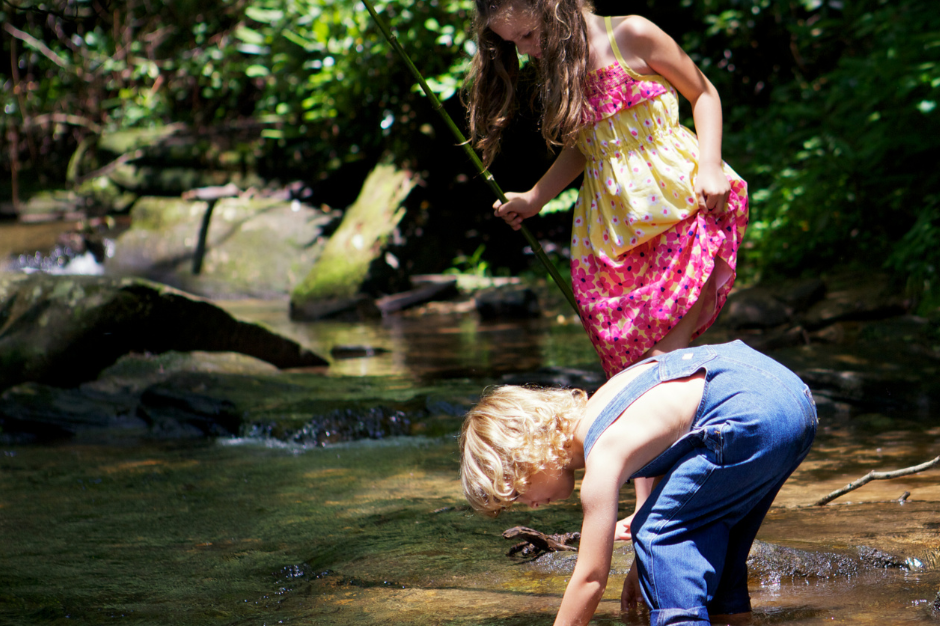Updated August 2025
Creeks have a magical way of pulling children in. The sound of rushing water, the glimmer of sunlight on ripples, and the thrill of discovering crayfish, minnows, or skipping stones all make for unforgettable experiences. For families and homeschoolers, a creek becomes more than just a pretty place to visit—it becomes an outdoor classroom brimming with science, art, and adventure.
Creeks and streams provide a place for children to explore nature. Around creeks, kids can see various animals and plants that make up a complex food web. Everything is connected, and the survival of one animal is often dependent upon the survival of another.
This guide will give you fun, hands-on activities designed for elementary-aged students, but they’re just as engaging for parents and older siblings. You don’t need expensive equipment or a science degree—just a bit of curiosity, a willingness to get your feet wet, and a sense of wonder.
Creeks have a magical way of pulling children in!
Why Creeks Make the Perfect Outdoor Classroom
Creeks are living ecosystems. They’re home to fish, insects, amphibians, plants, and even mammals that come to drink or hunt. The flowing water provides endless opportunities for learning about science, ecology, and even physics. Children learn best when they are engaged with their senses—touching rocks, listening to frogs, smelling damp earth, and seeing dragonflies zip past.
For homeschoolers, a creek study blends science, art, literature, and physical activity. It’s kinesthetic (hands-on), visual, and auditory all at once. For families, creek time creates lasting memories and builds a child’s love for nature—something that’s becoming increasingly important in our technology-heavy world.
Children who explore creeks can learn about the animal and plant life cycles surrounding creek habitats. In addition, they will understand how creek waters connect everything upstream, both good and bad, to everything downstream.
Safety First
Before we dive into activities, a quick word on safety:
Supervision: Always keep children within sight, especially younger ones.
Shoes: Wear sturdy water shoes or old sneakers to protect feet from sharp rocks and glass.
Awareness: Watch for slippery stones, deeper pools, and faster currents.
Leave No Trace: Teach children to respect the creek—no littering, no pulling up plants, and gentle handling of animals.
With that in mind, let’s wade right into the fun!
Homeschool
For homeschooling families, creeks provide natural integration across multiple subjects. You'll find yourself covering biology, chemistry, physics, geography, and even history as you explore together.
The best part? Kids don't realize they're "doing school" when they're splashing around and making discoveries.
check out my Store Resource Page
Creek Critter Safari
Bring a small net, plastic container, or even a clear jar, and let children gently scoop up tiny creek inhabitants. Take some time to look at them and gently place them back in their home.
Common finds include:
Minnows and tadpoles
Crayfish hiding under rocks
Mayfly or dragonfly larvae clinging to stones
Snails and aquatic beetles
Encourage observation rather than collection. Have children sketch their finds or make notes: “This crayfish was hiding under a flat rock. It had two claws and wiggled backward.”
This introduces kids to the idea of ecosystems and food chains. A crayfish, for example, is both predator and prey—a perfect opportunity to talk about balance in nature.
Investigating Benthic Invertebrates
Benthic macroinvertebrates are aquatic animals and include insect larvae, snails, crayfish, and mussels. Find out what is common in your area.
When exploring a creek, children love to find aquatic invertebrates that are a part of the creek ecosystem. These invertebrates are a necessary piece of the creek food web. Many animals, such as frogs, fish, birds, otters, and snakes, rely on aquatic invertebrates as food.
Snails and mussels are easy to observe because they sit on rocks or at the bottom of the creek, in full view from the surface, and move slowly. You can pick them up safely, examine them, and then put them back where you found them.
Aquatic insect larvae and crayfish are more secretive and require children to hunt to find them.
Crayfish or crawdads as we call them in the south, can be captured by picking up rocks they are hiding under and backing them into a net. Handle these animals with care because they have claws that can deliver a painful pinch to unsuspecting fingers.
Middle School Students use a kick net to collect stream insects. You can purchase a kick net here Photo Credit: Gary Peeples. U.S. Fish and Wildlife Service Southeast Region
Alternatively, you can use a butterfly net although are typically not as sturdy.
Great Resources for identifying stream invertebrates
Online ID keys are available to download from the Izaak Walton League. Adults may need to help children identify the aquatic insect larvae.
Invertebrates are a key indicator of the health of the stream. Older children can use a macroinvertebrate identification key to determine the relative health of the stream based on the insect families represented in the sample. This checklist comes from Maryland but you can find out if your state is monitoring streams.
Check out my Wildlife Tracks Activity book on Amazon
Discovering Secretive Animals
Most animals that live around creeks are shy and hide from people. These animals are often only active at night, such as beavers and raccoons. When exploring the area around the creek, children can discover which animals use it based on animal signs they find.
One easy sign to locate is animal scat or poop. Biologists use animal scat to determine which animals use the area for hunting or sleeping. Every animal has poop that looks slightly different. Online tutorials containing pictures can help identify which animal left behind the scat kids find.
Animal tracks are another sign left by secretive, hidden animals that live around creeks. Each animal species has a uniquely-shaped foot, claw, or hoof that leaves a unique impression on the ground. Because the terrain around streams is soft and often muddy, animals leave their tracks behind when they use the creek.
Some animals leave behind more than scat and tracks when they use a creek. Animals like otters and raccoons leave behind “trash” or a midden when they hunt and eat food. Piles of shells from snails and mussels indicate that an otter or raccoon feasted in that spot.
If you have a pond near you check out my article Explore A Pond
Spotting and Observing Fish
Small fish, such as minnows and darters, often inhabit creeks. These fish can be challenging to see or observe because they are fast swimmers. They often dart around quickly, moving from one hiding spot to another. Kids can see them after catching them with a net.
If the net catches minnows, turn the net over so the minnows fall into a clear plastic container filled with water to observe their appearance. Children should not touch the fish directly because their bodies are delicate.
Handling the fish removes the scales which they need for protection, so children should only make observations with their eyes. Touching minnows with dry hands can damage their scales and mucous covering. After observing the fish, gently return them to the creek.
Creek Scavenger Hunt
Make a list of plants and animals found in your ecosystem. Here is a list of common things to look for:
A nest hole in a tree, squirrel nests
Woodpeckers, robins, bluejays, and Grosbeak
Tadpoles, minnows, crayfish, and snails
Cattails, willow trees, and birch trees
Frogs and salamanders
Check out our YouTube Channel! @foxruneec
Racing “Boats”
Creek waters flow fast and slow, depending on where the water is in the creek bed. Along the shoreline, plants and other debris interfere with water flow and cause it to be slower than the water in the deeper channel, or thalweg.
Children can learn the basics about stream flow in creeks by racing makeshift “boats.” Kids can make boats out of any natural materials lying around, including small sticks, leaves, and pieces of bark. Any item that floats is suitable to use for this activity.
Younger children can have a race where they drop their “boats” into the water and see which item crosses the pre-determined finish line first. Older children can take this activity a step further by timing how long it takes for their “boats” to reach the finish line.
After a few races, older kids may start to ask questions and experiment to see what kind of floating item makes a faster boat. Some kids may want to time their floating vessel to see how long it takes to finish when they start from different places.
Racing makeshift boats is a simple way to introduce the topics of stream flow and hydrology to kids. It also reinforces the idea that creeks carry good and bad things from upstream to downstream.
This activity helps children understand why keeping our streams clean from trash and pollution is necessary to protect the downstream environment. After all, all streams eventually lead to the oceans.
The Art of Skipping Stones
Skipping stones is more than just fun; it’s physics in action. Show children how a flat stone, when tossed just right, can bounce across the water.
Ask: Why does a flat stone skip while a round one plunks?
Count how many skips each child gets.
Turn it into a friendly competition, or simply celebrate each success.
This blends physical science (motion, angles, force) with joyful play.
Author, Ame Vanorio, is the founder of Fox Run and teaches classes in the community and online.








